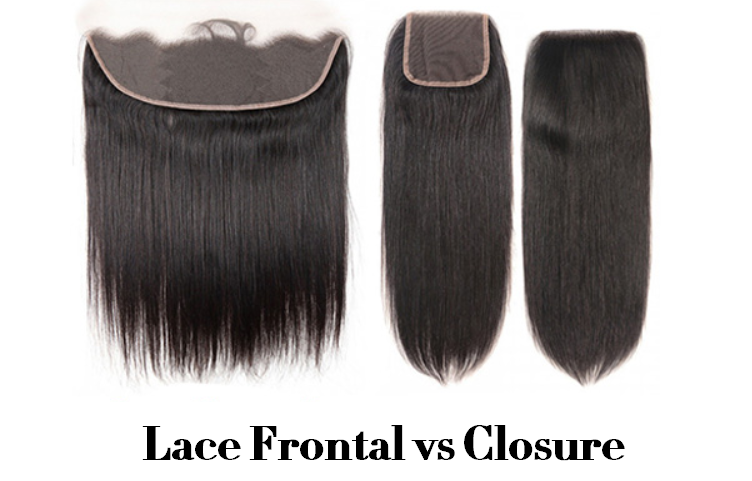Lace Frontal vs Closure - What's the Difference Between Closure Wig and Frontal Wig
Various wigs have gained in popularity over the years; it’s hard to tell each type of wig in a short time. Being among the hottest choices, frontals and closures are the best candidates for those seeking a wig instead of their natural hair. In this article, we'll introduce what a lace frontal and lace closure are, and also get into the difference between a closure wig and a frontal wig to determine which one to choose.

What Is a Lace Frontal?
A frontal is a type of hairpiece or half wig that covers the front part of the head, typically from ear to ear across the forehead. Different types of frontal can be divided by size and base. Lace frontals are made with delicate lace material that mimics the appearance of a natural scalp, allowing hair to look like it is growing directly from your skin. Lace frontal wigs generally come in sizes like 13*4, 13*5, and 13*6. The most popular one is 13*4, which means 13 inches from ear to ear and 4 inches of parting space from front to your apex. Because of its wide coverage, a lace frontal offers great versatility in styling, you can part your hair anywhere, pull it back into ponytails, or create updos.
Advantages of Lace Frontals:
Lace frontals stretch from ear to ear, offering full hairline coverage for a natural look.
They allow versatile styling, including multiple parting options and pulled-back hairstyles.
The lace material is breathable, promoting scalp health underneath the frontal.
They create a seamless, natural hairline that looks like real hair growth.
Disadvantages of Lace Frontals:
Frontals can be expensive due to their size and complexity.
They require expert skill to blend the lace color perfectly with your skin tone.
Premade sizes may not fit every head shape, sometimes needing professional customization.
Maintenance can be time-consuming, as the lace is delicate and may need frequent care.
Difference Between a Lace Frontal and a Full Lace Wig
A lace frontal covers only the front part of your head, usually from ear to ear, allowing you to style your hair away from your face. A full lace wig, on the other hand, has lace covering the entire head, which lets you part your hair anywhere and create many hairstyles. Full lace wigs tend to be more flexible and natural-looking but are usually more expensive and require careful care.
What Are the Different Types of Frontals?
1. Types by Lace Material:
Swiss Lace Frontals: Made from a soft, thin lace that feels gentle on the scalp. It provides a natural look but can be delicate, so it needs careful handling.
French Lace Frontals: This lace is thicker and stronger than Swiss lace, which makes it more durable and longer-lasting. However, it might be more noticeable on the scalp because it’s less transparent.
HD Lace Frontals: HD means high definition. This lace is ultra-thin and almost invisible when applied, blending perfectly with your scalp for the most natural look. It’s delicate and requires extra care to avoid tearing.
2. Types by Size:
13x4 Frontals: This size means the lace is 13 inches wide (ear to ear) and 4 inches deep (front to back). It covers the entire hairline and allows you to part your hair anywhere along the 4-inch depth. It’s the most common frontal size and offers great styling flexibility.
13x6 Frontals: These are wider and deeper, 13 inches wide and 6 inches deep, giving you even more space to part and style your hair. This size can create a more natural scalp appearance and is great for bigger hairstyles.
Other sizes: Some frontals come in smaller or larger sizes like 13x5, 10x4 or 14x4, depending on personal preference and the desired coverage.
3. Types by Hair Texture or Style:
Straight Frontals: These have straight hair strands and give a sleek, smooth look.
Wavy Frontals: These frontals have a natural wave pattern, adding volume and bounce.
Curly Frontals: These feature curly hair for a fuller, textured appearance.
Kinky or Coily Frontals: Designed to match natural Afro-textured hair, these frontals have tight curls or coils for a very natural look for people with curly hair types.
4. Types by Hair Density:
Low Density Frontals: These have fewer hair strands per square inch, giving a thinner, more natural look. Good for people who want a subtle appearance.
Medium Density Frontals: These have a balanced amount of hair, offering fullness without looking too thick.
High Density Frontals: These contain many hair strands for a thick, voluminous look, suitable for people who want a bold hairstyle.
What Is a Lace Closure?
A lace closure is a smaller hairpiece that is typically around 4x4 inches, also available in slightly smaller or larger sizes like 5x5, designed to cover a specific area at the front or top of your head. Like lace frontals, closures use lace (or silk) to create a natural-looking scalp, but with a much smaller surface area. Because the lace area is limited, closures allow fewer styling options; you can usually only part your hair in the middle or on the side. Closures are often chosen for their affordability and ease of maintenance. A closure wig is easy to take on and off. They are ideal for those who want a simple, protective style or need to cover thinning or balding areas without the need for complex hairstyles. There are different types of lace closures, such as transparent lace closure, HD lace closure, and more.
Advantages of Lace Closures:
Closures are more affordable than frontals because they use less lace material.
They are easier and quicker to install, making them beginner-friendly.
Closures require less maintenance and tend to stay in place longer.
They provide excellent protection for natural hair and help cover thinning areas.
Disadvantages of Lace Closures:
Closures offer limited styling options, restricting you to a few parting styles.
You can’t usually pull your hair back or create ponytails with closures.
The smaller lace area means less natural scalp coverage compared to frontals.
Regular salon visits may be needed to manage hair growth around the closure.
Do Lace Closures Damage Hair?
Lace closures themselves don’t usually damage your natural hair if you use them carefully. They are small pieces of lace with hair attached that cover parts of your scalp to protect your own hair underneath. But if you glue or sew them on too tightly, or don’t take care of your scalp properly, it might cause some hair breakage or irritation. So, gentle handling and good hair care are important to keep your hair healthy while using lace closures.
Difference Between Silk and Lace Closures
Silk closures have a thin silk layer under the hair strands, which hides knots and makes the scalp look very natural, like your real skin. Lace closures have tiny knots tied directly on the lace, which can sometimes be more visible. Silk closures are better if you want a flawless scalp look, while lace closures are lighter and more breathable.
Is There a 4 by 6 Closure?
Yes, a 4 by 6 closure means the lace piece measures 4 inches wide and 6 inches long. This size is bigger than the common 4 by 4 closures, giving you more area to part your hair and style it more naturally. It offers better coverage and more flexibility in hair styling.
How Long Do Lace Closures Last?
Lace closures can last anywhere from 6 months to over a year if you take good care of them. How long they last depends on how often you wear them, how well you clean and protect them, and the quality of the lace and hair. Gentle handling and proper maintenance help keep closures looking nice and strong for a longer time.
Lace Frontal vs Closure - What’s the Difference Between Closure Wig and Frontal Wig
1. Size and Coverage
Lace frontals are significantly larger than closures, typically measuring about 13 inches across and 4-6 inches back. This large lace base covers the entire hairline, offering full ear-to-ear coverage and creating a seamless, natural hairline. In contrast, lace closures are smaller pieces, commonly sized 4"x4" or up to 7"x7", designed to cover only a specific area on the crown or top front of the head. Closures provide a patch of lace that mimics a natural part but do not cover the full hairline.
2. Styling Versatility
Frontals offer superior styling flexibility as they allow for various parting options, including middle, side, or free part, and support updos, buns, and pulled-back hairstyles without exposing tracks. Lace closures mainly allow simple parting styles (middle, side, or three-part) and restrict styling mostly to down or loose styles. Pulling hair back with closures often exposes the tracks since the lace does not cover the entire hairline.
3. Comfort and Protection
Frontals are breathable and comfortable because they cover the hairline without fully covering the scalp, allowing airflow and reducing tension on the edges. However, the glue used can sometimes irritate sensitive scalps and potentially cause hairline damage if not applied or removed properly. Closures, installed without glue, are gentler on the scalp and provide excellent protection for natural hair underneath, so closure wigs are generally a safer choice for sensitive scalps or those wanting to protect fragile hair.
4. Cost and Durability
Although frontals require fewer hair bundles for a full look, their initial price is higher. Closures are typically more affordable, making them attractive for budget-conscious buyers. Closure wigs also tend to be more durable after installation because they require less manipulation and are sewn in securely, whereas frontals may only last 2-4 weeks before needing replacement or reinstallation. As a wholesale hair supplies vendor, HonestHairFactory.com offers exquisite Transparent Lace Frontal hairpieces and HD Lace Frontal with the lowest cost and best quality.
5. Installation and Ease of Use
Closures are easier and faster to install because of their small size. They are often sewn in and do not usually require glue, making them beginner-friendly and less risky for hairline damage. Lace frontals often need to be glued or bonded to the hairline, which can be more complex and time-consuming to install properly. The delicate lace around frontals requires careful trimming, blending, and sometimes plucking to achieve a natural look.
Closure wig vs frontal wig, which one should you choose? The versatility of closure wigs is a little bit more limited than with a frontal wig, if you are someone who only wears a side part, you are not going to pull your hair back, you are not going to put it behind your ear, you are not going to put it up in a ponytail, that’s how you always wear your hair and you don’t want anything else, then you should go with closure, then you can save a little bit of money instead of using a frontal. However, if you are someone who enjoys versatility, then you probably want to go for a frontal. Maybe one year or two years later, you may want to revamp your wig and do something different with it, such as change your part, add some color, etc.

